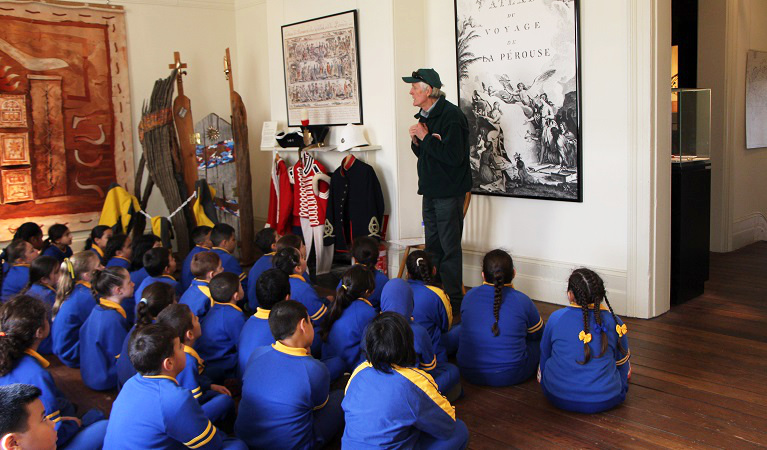School excursion
Stories of a different time at La Perouse
La Perouse area in Kamay Botany Bay National Park
Open, check current alerts
Overview
Stories from a different time is a fascinating Stage 1 (Years 1-2) history excursion at La Perouse. Students will learn about the first contact between the Aboriginal people, traditional custodians of the land, and the new British arrivals.
Read more about Stories of a different time at La Perouse
Historical concepts of past and present are brought to life through a fun dress-up and role-play activity.
Students will share in detailed accounts of James Cook's Endeavour landing in Australia.
They'll learn about famous natural sciences patron Sir Joseph Banks, who collected an abundance of new botanical specimens for study. Banks was also one of the first Europeans to compile a list of Aboriginal words.
For program outline, safety and practical information about this excursion, see info for teachers
| Stage | Stage 1 (Years 1-2) |
|---|---|
| Learning area | History |
| Student outcomes |
HT1-2. Identifies and describes significant people, events, places and sites in the local community over time HT1-3. Describes the effects of changing technology on people's lives over time HT1-4. Demonstrates skills of historical inquiry and communication |
| Objectives |
Students will:
|
Excursion details
- When
Weekdays during the school term, 10am to 2pm, including meal breaks
- Availability
- Guided. Available on request.
- Duration
- 4hrs
- Grading
- Easy. Guided tour and activities along an unsealed walking path including a board walk, grassed area and stairs.
- Price
-
$17 per student. Minimum of 20 students. GST included.
- Accessibility
- Hard
- Meeting point
- Bare Island gate. La Perouse is located at the northern headland of Kamay Botany Bay National Park. You can't access it through the southern end of the park at Kurnell.
- Equipment
provided - Yes
- Booking
- If you would like to organise a NPWS school excursion please get in touch with local staff or use the 'Enquire' link for the online form.
Local alerts
For the latest updates on fires, closures and other alerts in this area, see https://www.nationalparks.nsw.gov.au/education/stage-1-history-stories-of-a-different-time-la-perouse-kamay-botany-bay-national-park/local-alerts
Operated by
- School excursion inquiries - Sydney Harbour
- 02 9668 2006
- 02 9337 7012
- sydney.discovery@environment.nsw.gov.au
Park info
- in the La Perouse area of Kamay Botany Bay National Park in the Sydney and surrounds region
7am–8.30pm November to March.
7am–7.30pm April to October.
La Perouse park entry gate closed to vehicles between 7pm and 5am all year.
Areas may have to close at times due to poor weather or fire danger.
-
There are no park entry fees in La Perouse area but you'll need to pay to tour Bare Island. Park entry fees apply in the Kurnell area of Kamay Botany Bay National Park, only.
Buy annual pass.
Info for teachers
All the practical information you need to know about Stories of a different time at La Perouse.
Program outline
- Welcome, acknowledgement of Country and safety talk
- Explore the headland at La Perouse and discuss the history of the 1820s Macquarie Watchtower. It was the first customs building in Australia.
- Visit the monument to French naval explorer Lapérouse, after whom the site is named
- Learn about the La Perouse cable station and former Salvation Army home for women, also located at this site
- Walk across the wooden bridge to meet at Bare Island gate
- Introduction to the site and overview of what the excursion will entail
- Morning tea and toilet break on Bare Island
- Explore Bare Island and discuss early Aboriginal culture and Cook's landing spot in Botany Bay in 1770
- Discuss the fascinating discoveries of renowned naturalist Sir Joseph Banks
- Convict uniform dress-up and role-play
- Lunch and toilet break on Bare Island
- Discover the Happy Valley Great Depression camp of the 1930s, which was once located at this site
- Make our way back to the bus and depart
Getting there and parking
Get driving directions
Bare Island is located at the end of Anzac Parade in the La Perouse area of Kamay Botany Bay National Park. Follow Anzac Parade towards La Perouse. The area has coach and car parking, a museum, picnic areas, historic fort and a beach.
What to bring
Please wear fully enclosed shoes and bring a hat, sunscreen, wet weather gear, and lunch which should be low waste with a refillable water bottle. Students should bring gear in a backpack or similar (not plastic bags).
Maps and downloads
Risk assessment and risk benefits
Our rangers and guides have the technical skill and experience to assess the risks and the benefits of a variety of activities delivered as part of our learning programs.
We believe in including opportunities that allow students to learn and experience for themselves through exploration in the natural environment.
Please make your own risk assessment based on the information provided. Detailed potential risks and controls are provided for the site to assist teachers in risk management planning. Teachers and carers should be aware of, and consider the needs, abilities and medical conditions of students when visiting this site. The supervision of students remains the responsibility of the teacher. The school must ensure an adequate number of adult supervisors are present.
Accessibility
Disability access level - hard
Wheelchairs can access this area with some difficulty. The downstairs section of the museum is wheelchair accessible, but there are steps involved so you'll need some assistance. The upstairs section is inaccessible due to a narrow stairway. Please let us know in advance if you are bringing someone with special needs so that we can plan accordingly.

